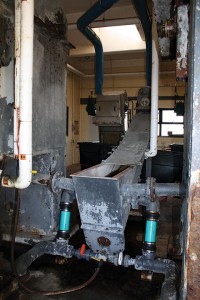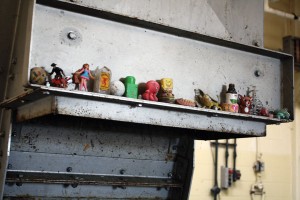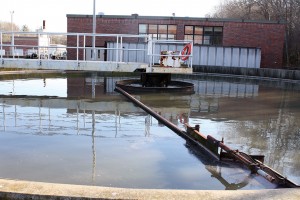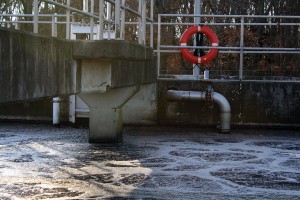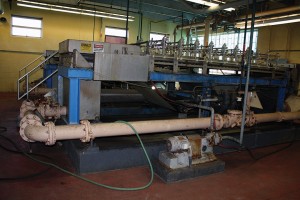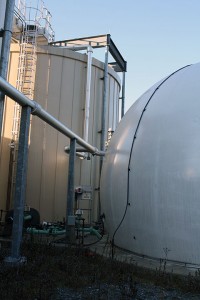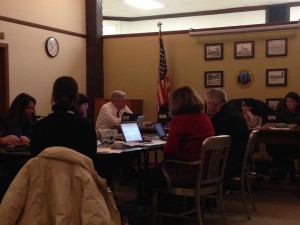We flush and forget about it. But what happens when your child asks for an in-depth elucidation on what happens to that which you put in the toilet once you flush it?
Of course, first you must admit that you actually don’t know all the details other than it runs through a pipe underground and goes to the wastewater treatment plant (or septic system) to be de-pooped and processed. Then you wonder how many other people wonder the same thing. So, you call your local wastewater treatment facility and ask for a tour. Or maybe that’s just what you do when you work for a newspaper, and it is your child that asked you.
Wastewater treatment. It has often appeared in our local news recently, especially with Marion facing an uncertain future of its own wastewater treatment facility in light of tighter restrictions suggested in the town’s renewal of the Environmental Protection Agency’s National Pollutant Discharge Elimination System (NPDES) permit.
Now might be a good time to learn some more about the business of your business, and we start today with #1 – kind of literally, actually. We start with the Fairhaven Wastewater Treatment Facility on Arsene Street in Fairhaven, which services some 1,780 Mattapoisett homes accounting for about 10-percent of the facility’s wastewater doodies. (We meant duties).
Fairhaven Department of Public Works Superintendent Vincent Furtado took us on a fun-filled flush-to-finish adventure of Fairhaven’s sewer treatment plant. So, let’s get this potty started with a little history about the facility before we take a trip that begins in your toilet and ends in the New Bedford Harbor.
The Fairhaven Wastewater Treatment Facility started herding turds back in 1969 and was upgraded in 1989 after the 1972 Clean Water Act was enacted requiring wastewater treatment plants to have a biological component to the treatment process as a way to reduce nitrogen pollution. The plant was again upgraded and fitted with a new anaerobic digester in 2012 thanks to a $7 million grant that helped fund the roughly $9 million project.
Mattapoisett, said Furtado, owns 16 percent of the facility and pays 16 percent of the cost of running it.
Designed to process up to 5 million gallons a day (MGD) of wastewater flow, it processes about 2.7 MGD and, during storm events, flows can peak at 16 MGD.
Two categories of wastewater are directed to the facility in two different pipes: sanitary sewer wastewater and storm sewer wastewater. Stormwater, although it can carry with it debris, requires less treatment than sanitary wastewater, so the process for treatment is shorter.
The process, once you flush your toilet, drain the washing machine, take a shower or drain the bath, takes from a half day to one day to complete.
From your house, the wastewater travels underground and is pulled by gravity through a pipe sized from 8 to 24 inches laid at a pitch, moving at a speed of 2 to 10 feet per second.
“If it went any faster, the water would go and the paper would stay behind,” said Furtado. The wastewater travels through one or more pump stations (depending on how far away your house is from the plant) before it reaches Arsene Street where the excitement begins.
The wastewater flows directly to the Preliminary Treatment (PT) building where the flow is pinched off and slowed to 1 foot per second to strain out the solids, debris, and grit picked up along the way.
“Solids remain in suspension, and the sand that’s being carried by the water falls out,” said Furtado. He described this PT process as something like a sieve or screen of parallel bars placed closely together to strain and separate paper and plastic debris flushed down the toilet.
The stuff that some people flush – plastic objects, plastic bags, diapers, sometimes figurines and toys – gets collected, raked up with a pitchfork, and thrown into large plastic bins for disposal into the landfill.
The PT Building is the first building on the right after passing through the chain-link fence that surrounds the site. A large pipe fitted with a hookup for pump trucks and RVs is situated at the bottom of the incline leading up to the building. About halfway up the hill is when the smell finally hits you.
It’s a swampy, swarthy mix of basement musk and fecal matter – sort of like a moist laundry hamper of dingy wet underwear that’s been sitting around a while. This smell is one of the subtle nuances of wastewater treatment plant scents that are in store for the visitor; however, these scents are a thing of the past to sewage treatment workers. Unless something out of the ordinary happens, they are immune to it – it’s a “been there, dung that” situation of the nose.
Then, as you open the heavy door to the PT Building, you know you are in the bowels of a sewer plant. The stench is the first to welcome you – until a collection of toys and odds and ends lined in a row attracts your eye, and it doesn’t take long to realize where the giant green Lego, plastic teeth, and Rudolph the Red-Nosed Reindeer figurine came from. (Oh, plastic SpongeBob, where you must have been and what you must have seen!)
There is wastewater running though the room from various channels that move through the strainers before exiting toward the #2 stop in the process: the clarifiers.
There are eight round concrete clarifiers on the site, but only two were running the afternoon of Thursday, January 14.
These 15-foot deep cement bowls hold the wastewater as heavier solids sink to the bottom and a metal arm skims the top of the water as oils float to the surface and are removed. It takes two to four hours in the clarifier to separate about 40 percent of the “sludge” (solid human waste) from the water.
At the waters edge surrounding the perimeter are 3- to 4-inch cement blocks that meet each other in a ‘V’ shaped notch where processed water flows out like a fountain and is run through to the next level: the aeration basin.
In the aeration basins, the grayish water is bubbled and makes a sizzling noise as it is oxygenated and introduced to anaerobic bacteria that, as Furtado put it, literally eat [crap] and die.
“You just let nature take over,” said Furtado.
The bacteria consume the suspended particles of solid waste, get fat, die off, and sink to the bottom where this next level of solid separation occurs. The water is carefully monitored by an on-site scientist for pH and quality to ensure the optimal environment for the little buggers to thrive.
“It’s like they’re in heaven. They’re having the time of their life,” said Furtado about the microscopic manure munchers.
The magic number for federal compliance, said Furtado, is 85, as in 85 percent purified.
“We are always at 90, 95, 96 … it depends on the day,” said Furtado. “The plant does a good job here.”
From the aeration basins, the purified water trickles out and flows through a UV light purification process before it leaves the facility through a pipe that flows toward the outfall site at the corner of Main and Church Streets in Fairhaven where it is then discharged into New Bedford Harbor.
Your actual waste, however, at this point still hasn’t completed its journey to its final destination which is one of two places: it is either trucked off to an incinerator in Woonsocket, Rhode Island to be burned, or it travels over to the solids processing building where it is shaped into yummy mud pies ready to eat – by bacteria in the new anaerobic digester, of course!
In this final stop before the digester, worker Bob Gomes takes charge of the solids processing. Gomes has worked in the plant for 20 years and has been manning the solids station for four years.
Gomes has been at it long enough to have lost his sense of wastewater smell at the plant. Yet, he can recall a scenario or two that could have “gagged a maggot,” as Gomes put it.
And Furtado reminisced with Gomes about a time when some students took a tour of the plant.
“Some of the girls had their hands like this,” Furtado said, putting his hand in front of his nose and grimacing. And when it was time to leave, they were out the door and gone as quickly as they could. “And I couldn’t smell a blessed thing. I was like, what are they smelling?”
And let’s just say, even though Gomes can’t smell it anymore, he now knows better than to go on a lunch run to Stop & Shop without changing his clothes first.
Gomes controls the volume of mud pie making, as well as the amount of mud pies that get sent to the digester.
In the digester, a happy colony of tiny poop-eaters thrives on your waste solids and happily burps out methane gas, which is collected and converted into electricity that is used to run the plant. Excess methane is released through a pipe into the atmosphere and the circle of life is complete.
Just like Marion, said Furtado, Fairhaven is waiting to hear back from the EPA about the requirements of its own NPDES permit. Furtado said he understands the EPA wants all municipalities to lower their nitrogen output, but he and the rest of the department are requesting scientifically-derived data to back-up the new pollution standards.
Furtado said the facility completed a 2014 pilot study on what the plant could do to further reduce nitrogen output utilizing a $90,000 grant from the Buzzards Bay National Estuary Program.
“We know it’s going to be expensive chemical-wise,” Furtado said. But with the equipment already at the facility’s disposal, Furtado said it is already successfully working towards a lower nitrogen output. “We’re a little ahead of the game … but the plant is environmentally sound.”
By Jean Perry
